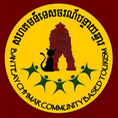February is a wonderful time of year to visit Banteay Chhmar. The weather is still cool and dry. This year, we were lucky enough to have a few nights of rain to help the dry season vegetable crops. One of the best sights this time of year is to watch the lotus flowers burst into bloom in the moat. You can take some beautiful photos early in the morning.
February is also the beginning of the cassava harvest. This root vegetable is a valuable dry season crop for the villagers. Cassava requires a great deal of backbreaking effort to harvest. Villagers can earn about 15,000 riel (almost $4) for a full-day’s work harvesting cassava. After harvesting, the cassava is normally cut with a small axe and left to dry for several days.
Normally, the villagers earn extra money for cutting the cassava for the farm owners. Two people working for 3 days can cut about 1 ton of cassava and they will earn about 700-800 Baht (about $30) each. A buyer then picks up the cassava and transports it to the border where it will be sold. The selling price is currently about 7 Baht (about .25¢) per kilo of dried, cut cassava.
We saw our good friend, Achii, from South Korea again this month. He brought another group of his friends to Banteay Chhmar. This was Achii’s 3rd trip here. He and his friends enjoyed a tour through the temple, listened to traditional music, took a bicycle & moto trip to Banteay Torp and ended their trip with a relaxing picnic in the shade before heading back to Siem Reap. They even brought some kimchi for the Khmer to taste – nice and spicy!





